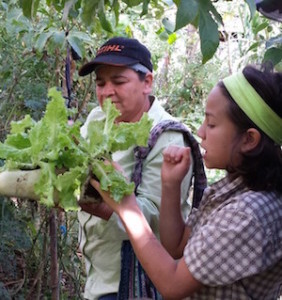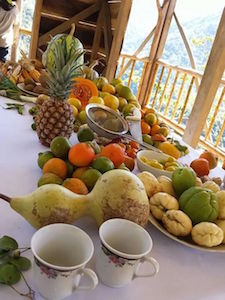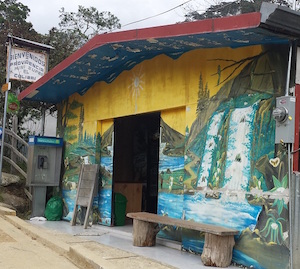By Ann C. Randall
ITWPA Member
 Dona Noire picked out a parachute-looking seed pod from a table laden with colorful fruits and vegetables and peeled back the outer layer to reveal a tiny yellow fruit inside. “The fruit of love,” she said, and handed it to us to eat. “This will be your breakfast juice tomorrow and after you drink it I will show you where it grows.” The following morning after a breakfast sourced entirely from her family farm, she led us through her garden pointing out not only her plants (she grows incense among her flowers and fruits) but also how the farm recycles ordinary items instead of buying materials. Used tires form steps and garden beds. Used rubber boots become the insulating base for the house. Broken glass gets mixed into concrete for benches. Discarded stuffed toy animals get turned into garden scarecrows.
Dona Noire picked out a parachute-looking seed pod from a table laden with colorful fruits and vegetables and peeled back the outer layer to reveal a tiny yellow fruit inside. “The fruit of love,” she said, and handed it to us to eat. “This will be your breakfast juice tomorrow and after you drink it I will show you where it grows.” The following morning after a breakfast sourced entirely from her family farm, she led us through her garden pointing out not only her plants (she grows incense among her flowers and fruits) but also how the farm recycles ordinary items instead of buying materials. Used tires form steps and garden beds. Used rubber boots become the insulating base for the house. Broken glass gets mixed into concrete for benches. Discarded stuffed toy animals get turned into garden scarecrows.
In the isolated rural community of Providencia in the Los Santos region of Costa Rica the residents have had to make do with what they have as both an economic and environmental necessity. Located about three hours south from San Jose, Providencia is reached seven miles off the Pan American Highway down a narrow, winding, dirt road that borders Parque Nacional Los Quetzales, the newest addition to Costa Rica’s expansive park system.
 The earliest settlers in the lush river valley were workers building the Pan American Highway in the 1930s. While hunting for food they followed the Brujo River and found a valley abundant with wild blackberries and a river teaming with fish that could sustain their families. Declaring it was Providence that led them to their discovery they built houses, grew food, and named their tiny community Providencia. In 1946 more families came over the mountains into the valley. The successive generations of those families still live in the same four neighborhoods that form Providencia de Dota: La Roca, La Piedra, Zapotal, and El Centro.
The earliest settlers in the lush river valley were workers building the Pan American Highway in the 1930s. While hunting for food they followed the Brujo River and found a valley abundant with wild blackberries and a river teaming with fish that could sustain their families. Declaring it was Providence that led them to their discovery they built houses, grew food, and named their tiny community Providencia. In 1946 more families came over the mountains into the valley. The successive generations of those families still live in the same four neighborhoods that form Providencia de Dota: La Roca, La Piedra, Zapotal, and El Centro.
Struggling to make a living, the residents have turned to rural tourism as an income source. Dona Noire, her husband, and their three children operate Armonia Ambiental Lodge in the organic farm we toured. Up the road in La Piedra, Ana and Enrique Calderon Aguero run a small lodge and restaurant named La Cabina la Piedra and subsidize their income by operating an adjacent coffee plantation. Their neighbor, Flora Valverde Elizondo, produces juices, jams, nectars, and salsa from both the wild and cultivated fruits and vegetables in the area. She sells them out of her home along with handicrafts made of recycled newspaper. Her enterprising young neighbors teach tourists how to make newspaper handicrafts by running art classes out of their houses.
 Within the last decade Providencia has been discovered as a prime location for bouldering (climbing small rocks without the aid of ropes). Organized and supported as a national sport by the Costa Rican Mountain Sports Federation, Costa Rican climbers have recently dominated Central American rock climbing competitions, a record that has been noticed by the international climbing community. A small but developing adventure tourist infrastructure is Providencia’s latest effort to bring economic stability to the community. Providencia guides offer bouldering and hiking excursions and an annual Bouldering Festival is sponsored each February. The local bouldering champion and guide, Sergio David Retana Calderson, can be found working at his family’s store in El Centro. Another resident guide, Adrian Fonseca Diaz, is building a lodge on the family’s riverfront property complete with an indoor climbing wall. There are rental cabinas available ranging from $15 to $25 a night per person. Ask at the El Centro store.
Within the last decade Providencia has been discovered as a prime location for bouldering (climbing small rocks without the aid of ropes). Organized and supported as a national sport by the Costa Rican Mountain Sports Federation, Costa Rican climbers have recently dominated Central American rock climbing competitions, a record that has been noticed by the international climbing community. A small but developing adventure tourist infrastructure is Providencia’s latest effort to bring economic stability to the community. Providencia guides offer bouldering and hiking excursions and an annual Bouldering Festival is sponsored each February. The local bouldering champion and guide, Sergio David Retana Calderson, can be found working at his family’s store in El Centro. Another resident guide, Adrian Fonseca Diaz, is building a lodge on the family’s riverfront property complete with an indoor climbing wall. There are rental cabinas available ranging from $15 to $25 a night per person. Ask at the El Centro store.
If you would like to purchase this article for your publication, please click here to contact the author directly.
Are foreign drugstores clinically appropriate for Americans. Part 2
